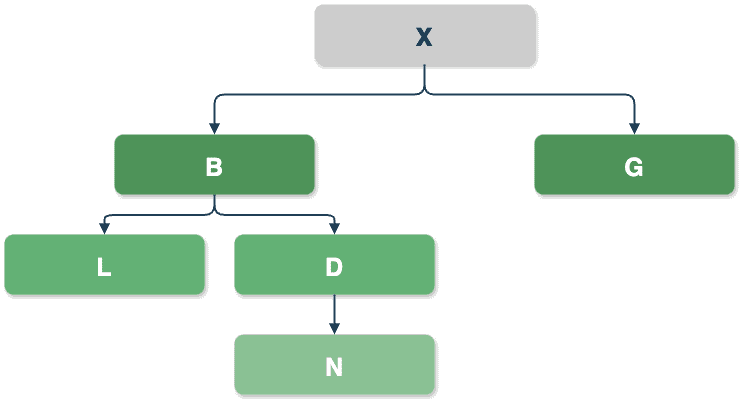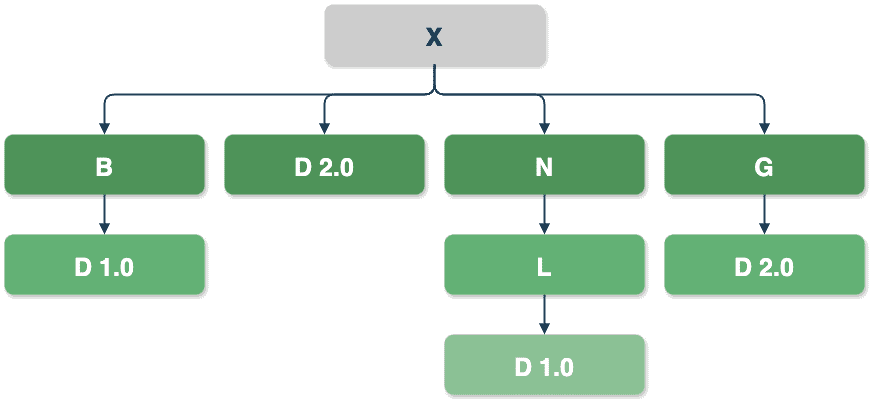1. 引言
Maven作为Java生态中最流行的构建和依赖管理工具,为我们提供了便捷的框架与库管理方式。但当项目依赖数量激增时,一些意想不到的问题就会浮出水面。
为避免这些编译时和运行时问题,我们需要掌握正确的依赖配置技巧。本文将深入探讨如何解决依赖版本冲突,并介绍检测和修复构件不一致性的实用工具。
2. 依赖机制
先快速回顾Maven的核心概念。
2.1. 传递依赖
传递依赖本质上是"依赖的依赖"。通过下图直观理解:

如图所示,我们的项目X依赖多个子项目。其中项目B又依赖L和D,此时L和D就称为X的传递依赖。如果D再依赖N,那么N也成为X的传递依赖。而项目G作为直接依赖且无其他依赖,就不会引入传递依赖。
Maven的核心优势在于自动管理传递依赖——我们只需在pom.xml中声明直接依赖(如B和G),Maven会自动处理整个依赖链。这对大型企业级应用尤其重要,因为它们可能涉及数百个依赖。
但这也带来了新问题:多个直接依赖可能需要同一JAR的不同版本。幸运的是,Maven提供了多种机制来限制依赖范围:
2.2. 依赖调解
我们重点讨论依赖调解机制。看这个典型场景:

Maven采用"最近优先"原则解决冲突:选择离依赖树根节点(X)最近的依赖版本。上例中:
- 直接依赖D 2.0被选中(路径X->D 2.0)
- 传递依赖路径X->G->D 2.0因版本相同被忽略
- 其他路径如X->B->D 1.0因版本冲突被忽略
当两个冲突依赖处于相同树深度时(如X未直接声明D),声明顺序起决定作用:先声明的依赖(如X->B->D 1.0)会被采用。
3. 依赖顺序问题
用Apache POI和OpenCSV的实战案例说明问题。两者都依赖Apache Commons Collections,但版本不同。
3.1. 实战案例
故意选择旧版本依赖制造冲突:
<dependencies>
<dependency>
<groupId>org.apache.poi</groupId>
<artifactId>poi</artifactId>
<version>5.3.0</version>
</dependency>
<dependency>
<groupId>com.opencsv</groupId>
<artifactId>opencsv</artifactId>
<version>4.2</version>
</dependency>
</dependencies>
通过mvn dependency:tree -Dverbose查看依赖树:
mvn dependency:tree -Dverbose
[INFO] --- maven-dependency-plugin:2.8:tree (default-cli) @ dependency-ordering ---
[INFO] com.baeldung:dependency-ordering:jar:0.0.1-SNAPSHOT
[INFO] +- org.apache.poi:poi:jar:5.3.0:compile
[INFO] | \- org.apache.commons:commons-collections4:jar:4.4:compile
...
[INFO] +- com.opencsv:opencsv:jar:4.2:compile
[INFO] | \- (org.apache.commons:commons-collections4:jar:4.1:compile - omitted for conflict with 4.4)
...
当前使用commons-collections4的4.4版本。该版本在4.2中新增了MapUtils.size(Map<?, ?>)方法。测试代码:
@Test
void whenCorrectDependencyVersionIsUsed_thenShouldCompile() {
assertEquals(0, MapUtils.size(new HashMap<>()));
}
✅ 测试通过。现在调整pom.xml中依赖顺序:
<dependencies>
<dependency>
<groupId>com.opencsv</groupId>
<artifactId>opencsv</artifactId>
<version>4.2</version>
</dependency>
<dependency>
<groupId>org.apache.poi</groupId>
<artifactId>poi</artifactId>
<version>5.3.0</version>
</dependency>
</dependencies>
❌ 重新编译后报错:
java: cannot find symbol
symbol: method size(java.util.HashMap<java.lang.Object,java.lang.Object>)
location: class org.apache.commons.collections4.MapUtils
再次检查依赖树:
$ mvn dependency:tree -Dverbose
[INFO] com.baeldung:dependency-ordering:jar:0.0.1-SNAPSHOT
[INFO] +- com.opencsv:opencsv:jar:4.2:compile
[INFO] | \- org.apache.commons:commons-collections4:jar:4.1:compile
...
[INFO] +- org.apache.poi:poi:jar:5.3.0:compile
[INFO] | \- (org.apache.commons:commons-collections4:jar:4.4:compile - omitted for conflict with 4.1)
...
现在使用的是4.1版本,该版本没有MapUtils.size方法。这就是典型的依赖顺序踩坑案例!
3.2. 依赖问题的常见异常
除了cannot find symbol错误,依赖问题还可能表现为:
- NoSuchFieldError
- NoSuchMethodError
- NoSuchMethodException
- ClassNotFoundException
- NoClassDefFoundError
⚠️ Maven插件执行时也可能报错:
[ERROR] Failed to execute goal (...) on project (...): Execution (...) of goal (...) failed: A required class was missing while executing (...)
最麻烦的是,部分依赖问题在编译时不会暴露,直到运行时才爆发。
4. 依赖问题解决工具
4.1. Maven Dependency Plugin
Apache Maven Dependency Plugin是依赖管理的瑞士军刀。通过它我们可以:
4.2. Maven Enforcer Plugin
maven-enforcer-plugin是项目规则的强制执行者。核心能力包括:
- 禁用特定依赖(直接或传递依赖)
- 检测重复依赖
- 强制依赖版本一致性
4.3. Maven Help Plugin
由于POM可能继承自父POM,最终配置可能分散在多处。maven-help-plugin的effective-pom目标能生成最终生效的POM,帮助我们快速定位配置问题。
5. 总结
本文系统介绍了Maven依赖管理的核心技巧:
✅ 依赖冲突解决原则:
- 深度优先:依赖树中离根节点最近的版本胜出
- 声明优先:同深度时,先声明的依赖生效
✅ 最佳实践组合:
- 定期更新依赖库
- 使用maven-enforcer-plugin强制规则
- 通过maven-dependency-plugin分析依赖树
- 利用effective-pom验证最终配置
掌握这些技巧,就能有效避免依赖地狱问题。记住:依赖顺序看似简单,实则暗藏杀机——尤其是在多模块项目中,一个顺序调整可能引发连锁反应。
完整示例代码见GitHub仓库